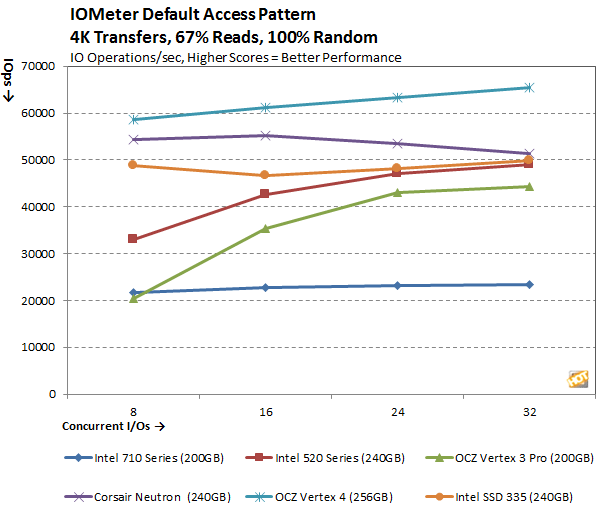Corsair Neutron SATA III SSD Review
Test Setup, IOMeter 1.1 RC
Our Test Methodologies: Under each test condition, the Solid State Drives tested here were installed as secondary volumes in our testbed, with a standard spinning hard disk for the OS and benchmark installations. Out testbed's motherboard was updated with the latest BIOS available as of press time and AHCI (or RAID) mode was enabled. The SSDs were secure erased and left blank without partitions wherever possible, unless a test required them to be partitioned and formatted, as was the case with our ATTO, PCMark 7, and CrystalDiskMark benchmark tests. Windows firewall, automatic updates and screen savers were all disabled before testing. In all test runs, we rebooted the system, ensured all temp and prefetch data was purged, and waited several minutes for drive activity to settle and for the system to reach an idle state before invoking a test.
|
Motherboard - Video Card - Memory - Audio - Hard Drives -
|
Hardware Used: Intel Core i7-2600K Asus P8Z6-V Pro (Z68 Chipset, AHCI Enabled) NVIDIA GeForce GTX 285 4GB Kingston DDR3-1600 Integrated on board WD Raptor 150GB (OS Drive) Samsung SSD 830 (256GB) OCZ Vertex 3 (200GB) Corsair Force GT (240GB) Crucial M4 (256GB) Corsair Neutron (240GB) Intel SSD 520 (240GB) OCZ Vertex 4 (256GB) |
OS - Chipset Drivers - DirectX - Video Drivers - |
Relevant Software: Windows 7 Ultimate SP1 x64 Intel 9.2.0.1030, iRST 10.5.1027 DirectX 11 NVIDIA GeForce 275.33 Benchmarks Used: IOMeter 1.1.0 RC HD Tune v4.61 ATTO v2.47 AS SSD CrystalDiskMark v3.01 x64 PCMark 7 SiSoftware Sandra 2011 |
|
As we've noted in previous SSD articles, though IOMeter is clearly a well-respected industry standard drive benchmark, we're not completely comfortable with it for testing SSDs. The fact of the matter is, though our actual results with IOMeter appear to scale properly, it is debatable whether or not certain access patterns, as they are presented to and measured on an SSD, actually provide a valid example of real-world performance for the average end user. That said, we do think IOMeter is a reliable gauge for relative available throughput within a given storage solution. In addition there are certain higher-end workloads you can place on a drive with IOMeter, that you an't with most other storage benchmark tools available currently.
In the following tables, we're showing two sets of access patterns; our custom Workstation pattern, with an 8K transfer size, 80% reads (20% writes) and 80% random (20% sequential) access and IOMeter's default access pattern of 2K transfers, 67% reads (34% writes) and 100% random access.


The Corsair Neutron performed relatively well in our IOMeter tests. When using IOMeter's default access pattern, the Neutron finished near the top of the charts, trailing only the OCZ Vertex 4 drive. With our Workstation Access pattern the Neutron also performed well, but finished about in the middle of the pack.

The Corsair Neutron's transfer speeds in our IOMeter tests position the drive in the middle of the pack, behind the SandForce and Intel-based drives.






